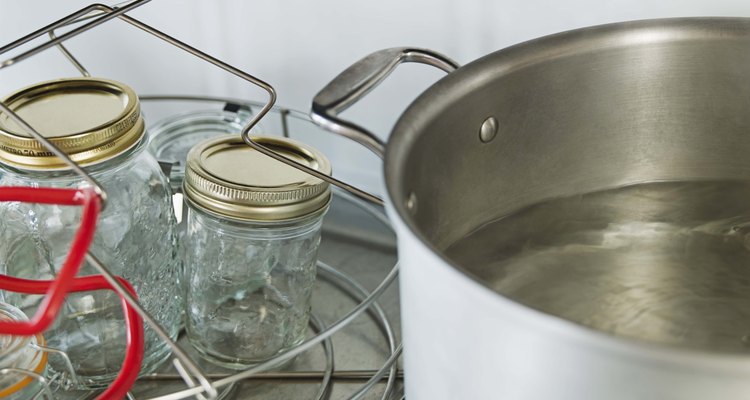
Jupiterimages/Brand X Pictures/Getty Images
If you love salsa and the taste of fresh summertime tomatoes, then try canning your own salsa. Growing your own garden will provide many fresh vegetables that you can enjoy during the winter by preserving their taste in canning jars. Many grocery stores carry the tools you need to begin canning and you can even buy packaged mix to create your own salsa. People often prefer to can their own salsa recipes. Personalized canned salsa makes great gifts for friends and family members and creates lasting memories when everyone makes the salsa together.
Use fresh and ripe tomatoes. Roma tomatoes work best due to their low water content. Clean the tomatoes of dirt and debris.
Place the tomatoes in a large pot of boiling water. Allow the tomatoes to boil for 1 minute.
Add the tomatoes to a bowl filled with water and ice. This will allow the skins to slide off the tomatoes. Remove and discard the skin from the tomatoes.
Cut each fresh tomato in half. Remove the seeds and excess water. Squeeze each tomato to remove the water and use a small spoon to scoop out the seeds.
Place the tomatoes in a colander. This will help remove any additional water.
Cut each tomato piece into half-inch cubes.
Place the jars, ring and lids in the dishwasher. This will sterilize them for canning. You can also sterilize everything in boiling water for 10 minutes.
Add the fresh tomatoes to a large pot. Follow the directions on the salsa mix to make the salsa. You can also make your own salsa mix by adding finely chopped onions, peppers, seasonings and tomato paste. However, you will need to follow a USDA approved recipe to ensure that your salsa stays safe once canned.
Fill each jar with the salsa using a jar funnel. Leave one-quarter of an inch for the head space in each jar. Place the lid on and screw the ring onto the jar.
Sit the jars in the canner. Add one to two inches of water to the canner. Process the pint-sized jars for 15 minutes. Altitudes higher than 1,000 feet will require 20 minutes and altitudes above 6,000 feet need to process for at least 25 minutes.
Remove the jars from the water. Allow them to cool and ensure they do not touch each other during this process. Check each jar to see that it sealed by pressing down on the lid. If you can press down on the lid and it springs back up, then the jar did not seal correctly. You will need to process the jars again with fresh new lids.
Related Articles

How to Blanch, Peel, & Freeze Whole ...

How to Can Green Tomatoes & Peppers ...

How to Store and Freeze Sundried ...

How to Freeze Fresh Tomatoes & Tomato ...

Red Currant Jam Recipe

How to Freeze Stewed Tomatoes

How to Make Tomato Juice From Fresh ...

How to Preserve Pimentos

How to Cook & Freeze Fresh San Marzano ...

How to Grill Tomatoes on a Stove

How to Make Delicious, Homemade ...

How to Process & Seal Hot Sauce Bottles

How to Dry Tomatoes in the Oven

How to Prepare Hungarian Wax Peppers

How to Skin Cherry Tomatoes

How to Make Tomato Bruschetta

How to Make Blueberry Jam

How to Can Pork Tenderloin in Half Pint ...

How to Preserve Chestnuts

How to Make Easy 5 Ingredient Fresh ...
References
Writer Bio
Angela LaFollette holds a Bachelor of Arts in advertising with a minor in political science from Marshall University. LaFollette found her passion for writing during an internship as a reporter for "The West Virginia Standard" in 2007. She has more than six years of writing experience and specializes in topics in garden and pets.
Photo Credits
Jupiterimages/Brand X Pictures/Getty Images